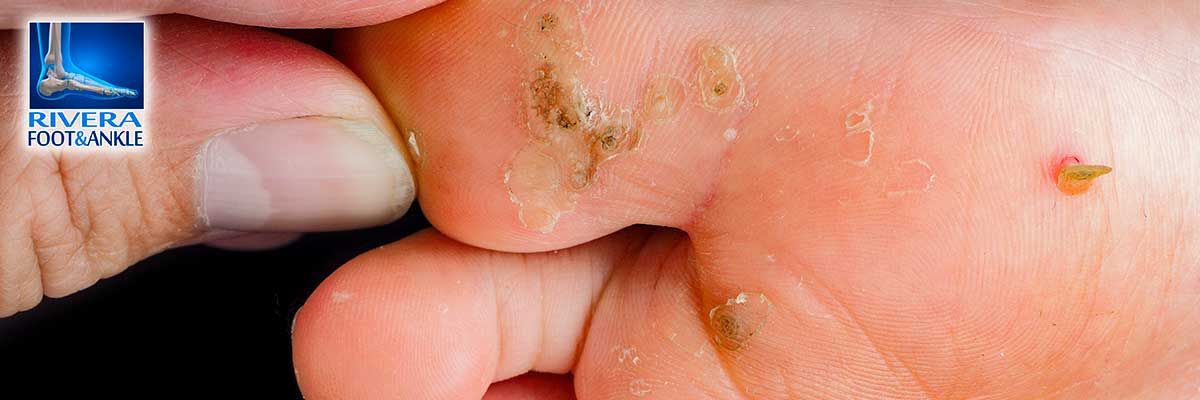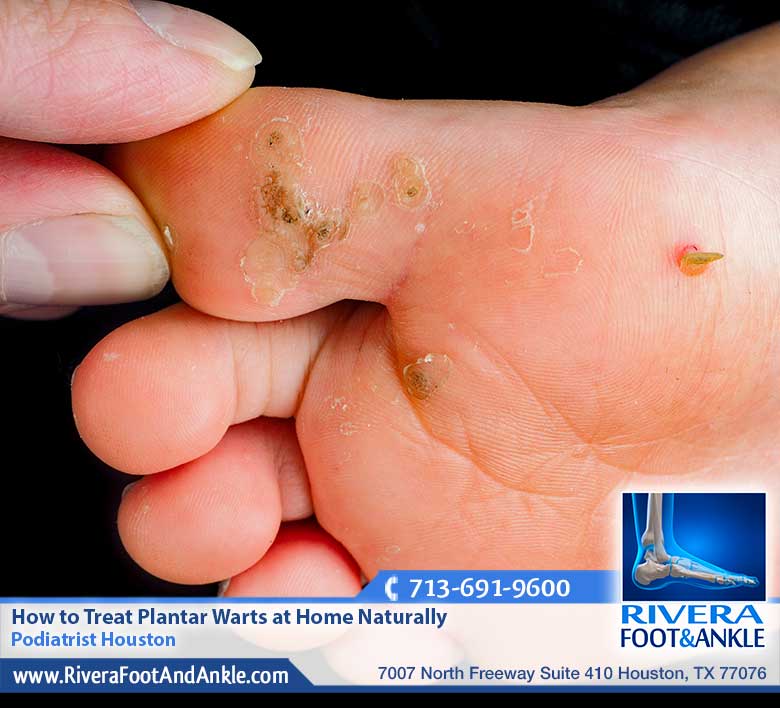
Podiatrist Houston
How to Treat Plantar Warts at Home Naturally
Overview
Plantar warts occur from a viral infection in your skin called the human papillomavirus (HPV). This virus can enter your skin through cuts. Plantar warts are common on the soles of the feet.
These types of warts can be painful, and the resulting raised bumps uncomfortable. Plantar warts also have “wart seeds,” or tiny black spots that are actually blood vessels. While not necessarily harmful, plantar warts can grow and eventually make it uncomfortable to stand and walk.
It’s possible to treat plantar warts at home, but it’s also important to know when you should see a doctor for medical treatment.
Plantar wart home treatment
While plantar warts aren’t dangerous, you might want to get them removed due to discomfort and aesthetic reasons. Any wart removal treatment will take several weeks, if not longer, according to the American Academy of Dermatology.
Apple cider vinegar
Apple cider vinegar continues to be studied for a wide range of health uses, including possible wart removal. A study Trusted Source suggests that the anti-infective properties of the vinegar can help reduce plantar warts. More research is needed to support this, however.
To use apple cider vinegar on your warts, apply with a cotton ball to the affected area twice daily.
Duct tape
One way to gradually get rid of plantar warts is by using duct tape. Stick a small piece of tape to the affected area, and then change the tape at least twice a day. (You might need to change the tape more often for warts on the bottoms of your feet.)
The idea behind duct tape for warts is that it can help “peel away” the layers of the warts. In theory, the wart will eventually peel completely away.
Salicylic acid
Salicylic acid is a type of beta hydroxy acid often used in acne treatment. It works by removing dead skin cells, which can sometimes clog your pores.
Higher concentrations of salicylic acid can be found in over-the-counter (OTC) wart creams and ointments. These products shed the skin around the wart little by little, until it’s eventually cleared up completely.
To get the most out of this treatment measure, you’ll need to apply the salicylic acid on your plantar warts twice per day, every day. It can also be helpful to prep the skin by soaking the affected area in warm water for 10 minutes before applying the acid.
It can take several weeks for the warts to completely go away.
Tea tree oil
Tea tree oil has been historically used as a topical antiseptic. It’s primarily used for fungal infections, wounds, and acne. While not widely studied, tea tree oil may also work for plantar warts.
To try this remedy, apply a small amount of tea tree oil diluted in olive or almond oil to the affected area twice a day.
Milk thistle
Milk thistle is another herbal remedy that may help clear up skin conditions. Unlike tea tree oil, milk thistle has been researched for its antiviral properties. You can apply diluted milk thistle extract to your warts twice a day.
Don’t use this product if you have a history of ragweed allergies.
Iodine
Iodine is an essential mineral that’s most often associated with thyroid health. But certain formulations can be used for other purposes too — this includes wart removal.
One study Trusted Source found that a combination product of providone-iodine topical solution helped clear up warts after twice-daily applications over the course of 12 weeks. You can buy both products from a drugstore.
Still, this type of treatment is best used while under a doctor’s supervision, especially if you have any underlying chronic illnesses like thyroid disease.
OTC freezing sprays
Aside from salicylic acid, you can also buy “freezing sprays” at the drugstore for plantar warts. These liquid nitrogen-containing products are designed to mimic the effects of cryotherapy at a doctor’s office.
The spray works by creating a blister-like injury that sticks to the wart. Once the blister heals, the wart will go away too.
To use freezing spray, dispense the product directly onto your wart for up to 20 seconds. Repeat if necessary. The blister will form and fall off in about one week. After this time, you may decide to repeat treatment if the wart is still there.
You might have to repeat the process several times for up to six weeksTrusted Source.
RIVERA FOOT & ANKLE: At Orlando H.Rivera DPM, our priority is to deliver quality care to informed patients in a comfortable and convenient setting. When you have problems with your feet, you need to turn to a podiatrist who listens and responds… an experienced doctor who knows the field and can effectively diagnose and treat your needs… a friendly physician who counsels you on the best ways to maintain and improve your health. Our physician(s) meet all these criteria. Plus, you benefit from a dedicated team of trained professionals who give you the individualized attention you deserve.

Podiatrist Houston
Foot and Ankle, Dr. Orlando Rivera, Advanced Foot & Ankle Specialist, Foot and Ankle Podiatry, Houston Foot & Ankle Surgical, Treatment of Foot and Ankle, Foot & ankle specialists, Podiatrist in houston, podiatrist in houston, Orlando H.Rivera DPM, Houston Foot Doctor, Foot and Ankle Surgeon Houston, Ankle and Foot Specialist Houston, Podiatrist Houston, Foot Pain Houston.



